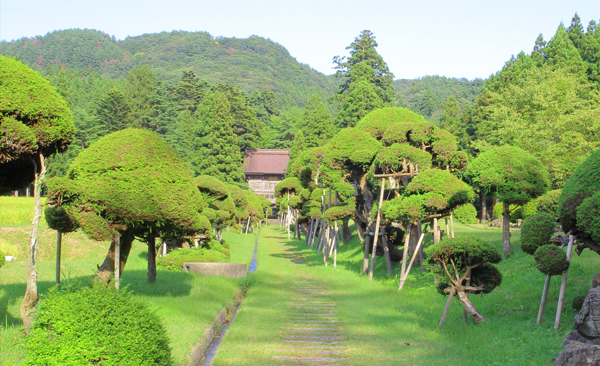
Hear the voices of the ancients who opened
up and made Shonai prosper a long time ago.
Yamagata Prefecture is divided into four districts, and one of them is the Shonai district. It lies in the western part of Yamagata Prefecture, facing the Japan Sea, and is now comprised of two cities and three towns. It is said that in medieval times, there were three large shoen (manors) in this district and the most prosperous was Oizumi (the current Tsuruoka City and its environs). Shonai originally means the inside of shoen, and it has come to mean the whole Shonai district in modern times. The country of Dewa was formed in Shonai in the year 712, which led the district to flourish.

This five-story pagoda stands on the foot of the Ichi-no-saka hill, the approach to the Sanjin Gosaiden Shrine at the summit of Mt.Haguro. It is the oldest pagoda in the Tohoku region, and is believed to have been built by a warlord Masakado Taira sometime between 931 and 937. With its simple yet solemn appearance, this graceful, 3-gen (about 5.4 meters) wide, five-story pagoda with roofs thatched with shingles of wood is believed to have rivaled building structures constructed in the capital of that time. In the Michelin Green Guide Japan, 2 stars have been awarded to this pagoda, as well as Mt.Haguro and the Sanjin Gosaiden Shrine.
Tsuruoka City, Haguro Buranch
 0235-62-2111
0235-62-2111

(Nationally Designated Historic Site)
These rice storehouses were constructed in 1893. The view of these 12 buildings alongside the zelkova trees that line the Niida River is the symbol of the rice-producing region of Shonai. This area is also famous for being a filming location for the NHK morning television series “Oshin” as well as various commercials, making it a popular photo spot.
Sakata Tourism & Industry Association
 0234-24-2233
0234-24-2233

Soko-ji is a noted temple of the Soto sect. It was founded by the priest Getsuan Ryoen in 1384 in the current Matsuyama of Sakata City. As many as 120 "mushroom" cedar trees that line both sides of the approach to the magnificent gate of the temple have been designated as a natural monument by Yamagata Prefecture. Behind the main temple is the beautiful garden called Horaien designed by Kobori Enshu, a celebrated garden that is unique in the area which has been designated as a national historical relic site.
Soko-ji
 0234-62-2170
0234-62-2170

The deity of Omonoimi is enshrined at the summit of Mt. Chokai in Yuza Town, and its town shrines called Kuchi-no-miya are in Fukiura and Warabioka at the foot of Mt. Chokai. The Omonoimi shrine is believed to have been built in the reign of Emperor Kimmei. Every year, the Reitaisai festival is held on May 5, and the Shunjusai festival to pray for harvest is held in spring and fall.
Mt. Chokai Omonoimi Shrine
 0234-77-2301
0234-77-2301

Zempo-ji, a temple of Ryujin (dragon god), has a number of believers in the Tohoku region and Hokkaido. It is religiously worshipped as a guardian deity of fishermen. It is a historic temple with structures such as the main gate, the main temple, the Ryuo-den building, and the five-story pagoda arranged neatly in the precincts.
Zempo-ji
 0235-33-3303
0235-33-3303

This temple was formerly a branch temple of the Churen-ji temple of Mt. Yudono. It belongs to the Chizan sect of Shingon Buddhism. It is dedicated to sokushinbutsu (mummies) of Saint Chukai and Saint Emmyokai who attained Buddhahood while alive through Mt. Yudono ascetic training.
Kaiko-ji
 0234-22-4264
0234-22-4264

Sericultural industry was founded in Matsugaoka, which samurai warriors of the Shonai feudal domain cultivated right after the Meiji Restoration. Five silkworm-rearing houses remain to this day and one of them is used as a museum.
Matsugaoka Pioneer Museum
 0235-62-3985
0235-62-3985

(Hiyoriyama Park)
Sengoku-bune is a Japanese-style wooden ship that sailed westward (from the Japan Sea to Shimonoseki andto the Kansai region) from the middle Edo period to the early Meiji period. The half-size restoration stands at the pond in the Hiyoriyama park in Sakata City.
Sakata City, Tourism and Local Products Division
 0234-26-5759
0234-26-5759

(Nationally Designated Scenic Garden)
This garden is located on the grounds of Gyokusenji Temple, which was founded in 1251. Its lovely seasonal flowers have earned it the nickname “Flower Temple”. Its pure community of Japanese primrose flowers is a rare sight in Japan, and it attracts a large number of visitors from mid-May to early June.
Gyokusenji Temple
 0235-62-2746
0235-62-2746

(Former Kazama Residence)
Kazama was a wealthy merchant who thrived by benefiting from the patronage of the Shonai domain. Heishin-do was built in 1896 as a residence-cum-store in the ruins of an old samurai residence. It has been designated as an important national cultural asset.
Heishin-do
 0235-22-0015
0235-22-0015